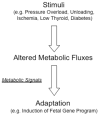Return to the fetal gene program: a suggested metabolic link to gene expression in the heart
- PMID: 20201903
- PMCID: PMC3625436
- DOI: 10.1111/j.1749-6632.2009.05100.x
Return to the fetal gene program: a suggested metabolic link to gene expression in the heart
Abstract
A hallmark of cardiac metabolism before birth is the predominance of carbohydrate use for energy provision. After birth, energy substrate metabolism rapidly switches to the oxidation of fatty acids. This switch accompanies the expression of "adult" isoforms of metabolic enzymes and other proteins. However, in a variety of pathophysiologic conditions, including hypoxia, ischemia, hypertrophy, atrophy, diabetes, and hypothyroidism, the postnatal heart returns to the "fetal" gene program. These adaptive mechanisms are also a feature of the failing heart muscle, where at a certain point this fetal-like reprogramming no longer suffices to support cardiac structure and function. We advance the hypothesis that in the postnatal heart, metabolic remodeling triggers the process through glycosylation of transcription factors, potentially protecting the stressed heart from irreversible functional impairment and programmed cell death. In other words, we propose a metabolic link to gene expression in the heart.
Conflict of interest statement
The authors declare no conflicts of interest.
Figures




References
-
- Rajabi M, et al. Return to the fetal gene program protects the stressed heart: a strong hypothesis. Heart Fail Rev. 2007;12:331–343. - PubMed
-
- Bartelds B, et al. Perinatal changes in myocardial metabolism in lambs. Circulation. 2000;102:926–931. - PubMed
-
- Goodwin GW, Taylor CS, Taegtmeyer H. Regulation of energy metabolism of the heart during acute increase in heart work. J Biol Chem. 1998;273:29530–29539. - PubMed
-
- Smith R. Parturition. N Engl J Med. 2007;356:271–283. - PubMed
-
- Navaratnam V. Heart Muscle: Ultrastructural Studies. Cambridge University Press; New York: 1987.
Publication types
MeSH terms
Substances
Grants and funding
LinkOut - more resources
Full Text Sources
Other Literature Sources
Medical

